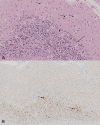Creutzfeldt-Jakob Disease: A Rare Case of Dementia
- PMID: 38021531
- PMCID: PMC10652161
- DOI: 10.7759/cureus.47177
Creutzfeldt-Jakob Disease: A Rare Case of Dementia
Abstract
Prion diseases are rare neurodegenerative diseases that have a rapid evolution. Creutzfeldt-Jakob disease (CJD) is the most common and its sporadic form the most frequent. Definitive diagnosis is only obtained through autopsy, and there are currently no available treatments. Here, we present a case of an 84-year-old woman presenting with resting tremor, abnormal gait, frequent falls, apraxia, visual hallucinations, and delirium. There were no signs of relevant metabolic, infectious, or nutritional alterations, and brain computed tomography (CT) scan and magnetic resonance imaging (MRI) had no significant findings. Two months later, the patient was completely immobile with mutism, seizures, and myoclonus. In the presence of a rapidly progressive dementia associated with myoclonus, it was hypothesized that the patient had CJD. The patient's clinical state deteriorated, she died, and autopsy confirmed sporadic CJD. The purpose of this case is to highlight a rare disease that can go undiagnosed because of low awareness and clinical suspicion and the importance of the differential diagnosis of dementia, a common disease at this age.
Keywords: case report; cognitive decline; creutzfeld-jakob disease; dementia; prion disease.
Copyright © 2023, Gouveia et al.
Conflict of interest statement
The authors have declared that no competing interests exist.
Figures

References
-
- Epidemiology of Alzheimer's disease and other dementias [Article in Spanish] Garre-Olmo J. Rev Neurol. 2018;1:377–386. - PubMed
-
- 013 Differential diagnosis of rapidly progressive dementia. Knight R. J Neurol Neurosurg Psychiatry. 2010;81:6.
-
- Sporadic human prion diseases: molecular insights and diagnosis. Puoti G, Bizzi A, Forloni G, Safar J, Tagliavini F, Gambetti P. Lancet Neurol. 2012;11:618. - PubMed
-
- A new variant of Creutzfeldt-Jakob disease in the UK. Will RG, Ironside JW, Zeidler M, et al. Lancet. 1996;347:921. - PubMed
-
- Mortality from Creutzfeldt-Jakob disease and related disorders in Europe, Australia, and Canada. Ladogana A, Puopolo M, Croes EA, et al. Neurology. 2005;64:1586–1591. - PubMed
Publication types
LinkOut - more resources
Full Text Sources
